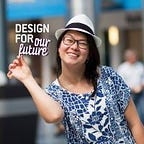Co-creation: the user as a co-designer
Designing products and services with the user in mind is a central point of the user-centered design. Use of fictional personas, creating usage scenarios and customer journey mapping are part of traditional methods designing user experiences. These methods have been very useful in uncovering the needs and wants of the target user, learning what they value and how to best address these needs.
The only problem with that is oftentimes, with complex problems and situations, the user may not know what they want. What they say may not entirely match what they do in reality. There is only so much we can observe or ask the user about.
These include the hidden desires of users; their latent feelings; and the future experiences of people, communities and cultures.
Here is when Co-creation comes in handy.
What is Co-creation?
Co-creation is a practice of collaborative creativity, that’s initiated by firms to enable innovation and create value with, rather than simply for their customers. Defined by Prof. Thorsten and his colleagues at London Research and Consulting group, the concept originated from economics and shortly stuck with designers.
Many companies have been embracing this practice extensively. A popular example is the website of www.NIKEiD.com that allows people to customise their own shoes, for example, by choosing colours and detailing. For some, it is on a subconscious level. IkeaHackers.net is a community site about modifications and repurposing of Ikea products, not affiliated with the company itself. The existence of such fan-run platforms prove that the user wants and needs to be part of the creative process.
The benefits
The Co-creation approach has various benefits:
- By involving real users in our creative process, we learn early in the process whether the idea or the product will be successful with the users.
- It helps to uncover the true needs and wants of the users.
- Consequently, it can lower costs and risks for the company
- It can decrease the time needed for research, development and filtering of ideas
- Consumers benefit from greater personalisation and value as a result of co-creation processes
- Building competitive advantage by turning the obtained knowledge from users into advance and improvement of products/services and eventually, user experiences
- Co-creation will enable creativity at individual and group level and potentially enable customer knowledge development and transfer across the organisation.
- Most importantly, the Co-creation has the benefit of bringing the researcher and the designer closer to their users.
Co-creation does not entitle only the consumers as stakeholders in the process. Involving clients in the innovation process increase their engagement in the project; generate a broad support from them as they are involved in the process; and enable smooth communication and interaction. Users and clients can become part of the design team as ‘expert of their experiences’ (Sleeswijk Visser et al. 2005), but in order for them to take on this role, they must be given appropriate tools for expressing themselves.
These thoughts and insights leave me with a question in my mind: what do these techniques and trends mean for our professions as designers, creativists, ideators? As our users are becoming co-designers, do we take role of a design manager instead then? What is the future of design as profession?
Post originally published at MOBGEN labs.
Eleonora is a UX designer currently solving complex problems at MOBGEN in Amsterdam. Follow her on twitter or connect on linkedin.
